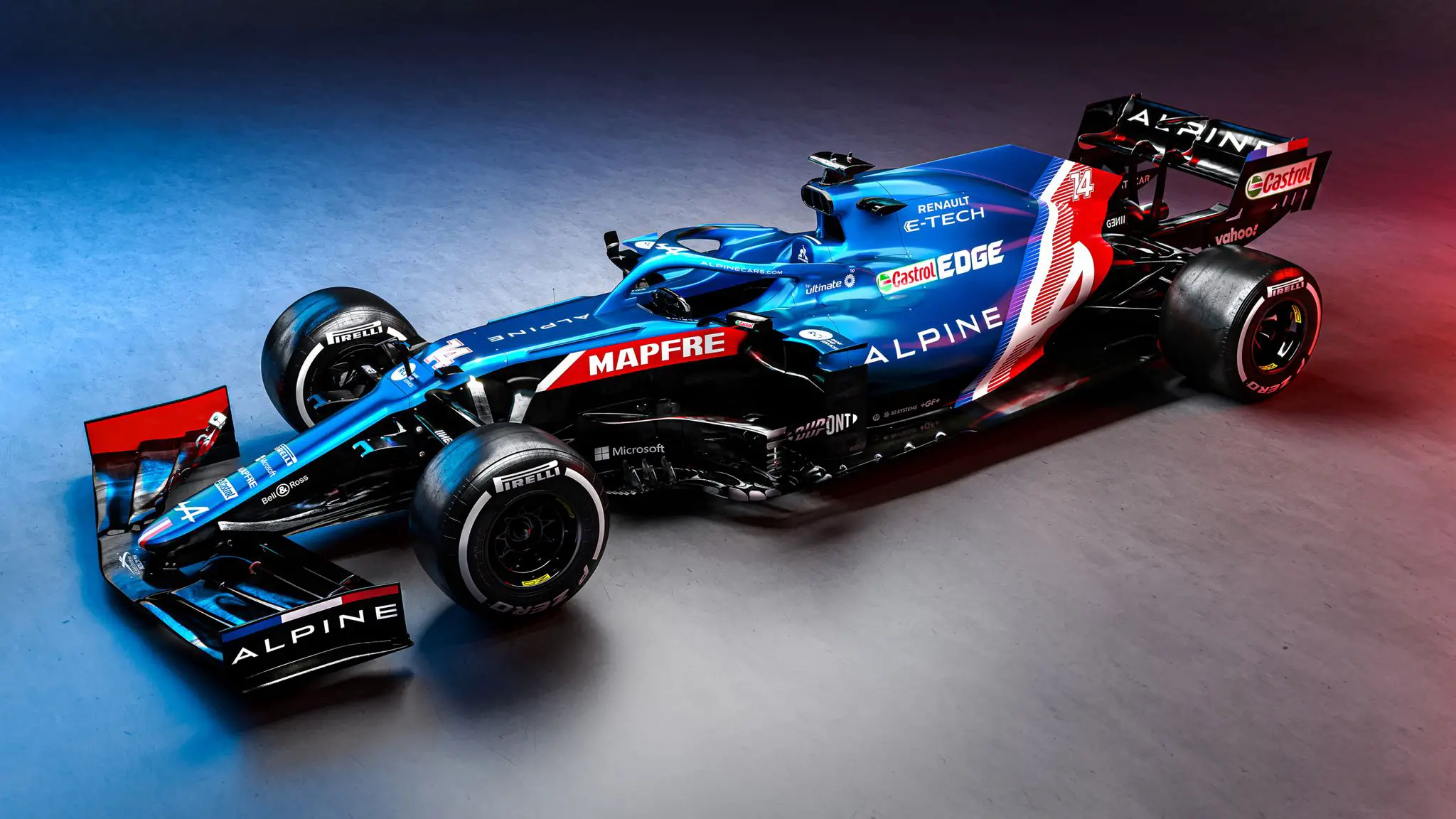The Alpine Renault F1 team has a long and storied history in Formula One racing. Founded in 1976, the team quickly became a top contender in the sport, largely thanks to the innovative designs of its founder and chief designer, Gerard Ducarouge.
The Alpine Renault F1 Team was a dominant force in the world of Formula One racing during its time. From its inception in the 1970s to its eventual merger with the Lotus team in the 1990s, the team left an indelible mark on the sport. In this article, we’ll take a closer look at the history and legacy of the Alpine Renault F1 Team.
The team has had several notable achievements, including multiple race victories, podium finishes, and even a world championship. In this article, we will explore the Alpine Renault F1 team’s history, achievements, and impact on the world of Formula One racing.
The Alpine Renault F1 Team History
The story of the Alpine Renault F1 team is essentially broken into two parts (Alpine and Renault)
The History of Alpine
Before we can understand why the Renault F1 team changed its name to Alpine, we must first understand the Alpine brand’s history and significance.
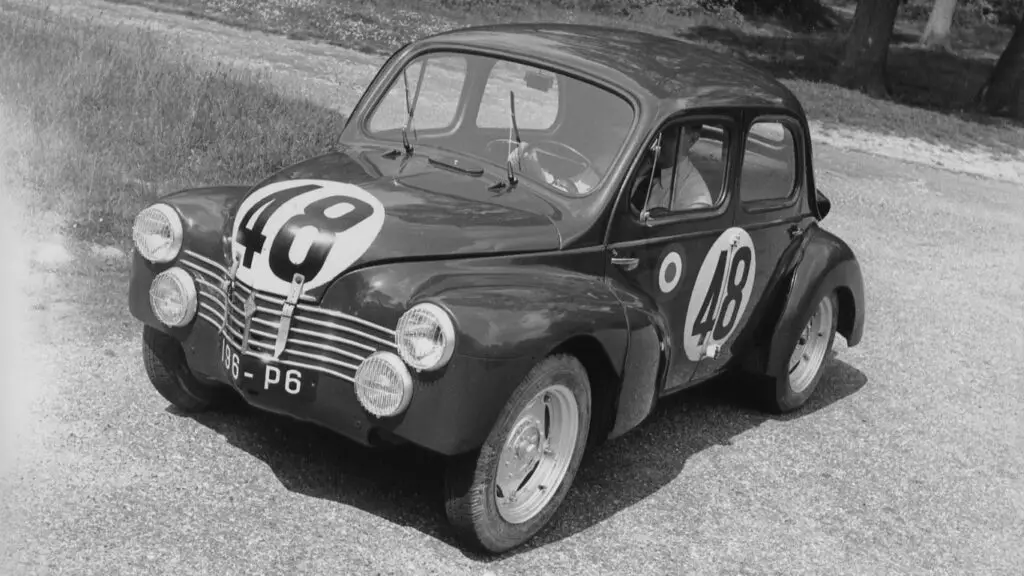
Alpine is a French manufacturer of high-performance sports cars, founded in 1955 by Jean Rédélé. Alpine developed a reputation for building lightweight, agile, and highly capable cars, popular among racing enthusiasts and sports car fans.
In the 1960s and 1970s, Alpine became heavily involved in motorsport, competing in various racing series and events worldwide. The company’s most notable success came in the World Rally Championship, where Alpine won the championship in 1973 with its A110 model.
In 1975, Alpine produced the prototype A500 prototype to test a 1.5 L V6 turbocharged on behalf of the Renault factory team. This car made its first F1 appearance in 1977.
Tolman Racing
The team first competed in Formula One in 1981 as Toleman, based in Wittney, England. Although In its 5 years of existence, Toleman never won a race, it is best remembered for kicking off Ayrton Senna’s career in 1984, during which he achieved 3 podium finishes.
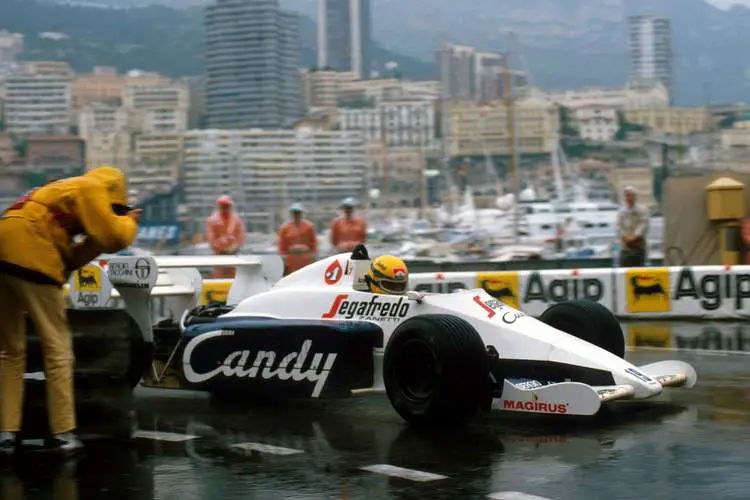
The car was unreliable, and Senna suffered from eight DNFs (Did Not Finish), including his first race at his home in Brazil.
Toleman’s Racing Records Are Listed Below
| Metric | Value |
|---|---|
| No Of Grands Prix Raced | 57 |
| Number of DNS (Did Not Start) | 46 |
| Number of seasons raced | 5 |
| Number of engine builders | 1 |
| Number of drivers | 10 |
| Number of car models | 7 |
| Number of pole positions achieved | 1 |
| Number of fastest laps | 2 |
| Number of podiums | 3 |
| Number of championship points | 26 |
| Points per GP raced | 0.46 |
| Points per season | 5.20 |
| Number of laps raced | 2,893 |
| Number of Km raced | 13,508 |
Benneton Enters The Scene
In 1986 the clothing company Benetton purchased Alpine and renamed the team Benneton F1.
Under the Benetton brand, it won the 1995 Constructors’ Championship, and its driver, Michael Schumacher, won two Drivers’ Championships in 1994 and 1995.
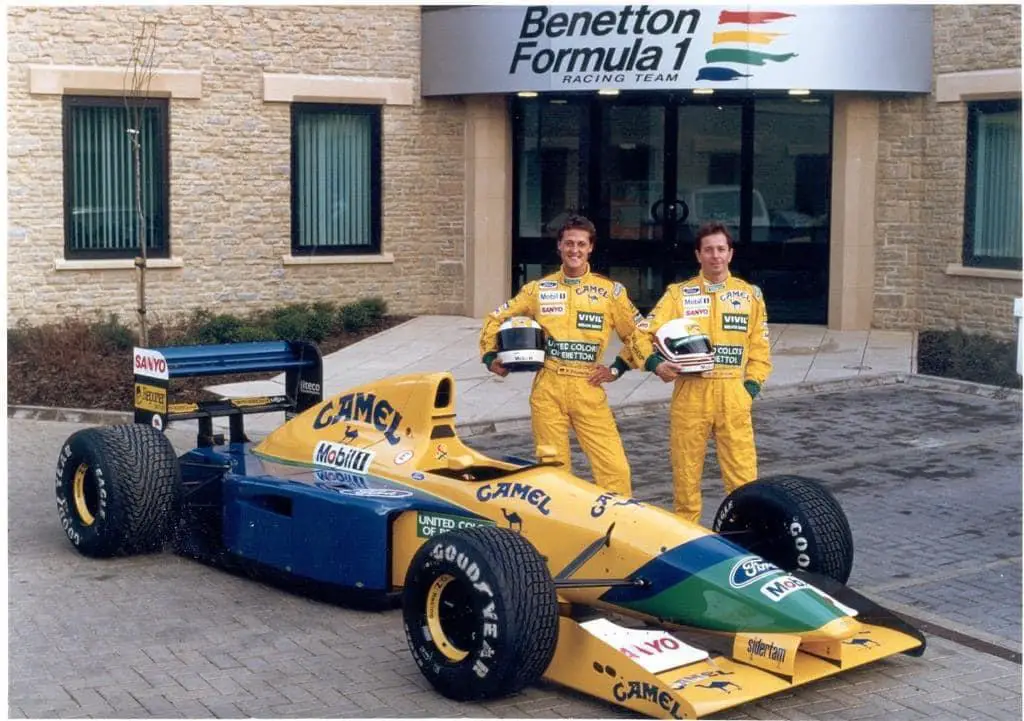
The time with Schumacher was not without controversy and involved a battle between him and Damon Hill. This led to several incidents, including:
- A race ban for ignoring black flags at Silverstone.
- Michael was disqualified in Spa after the team attached skid block wear to the car.
- The competition between the two in Adelaide proved to be the title decider.
In 1995, after Michael won his second driver’s championship, and Johnny Herbert supported him, Benetton won its first constructors championship.
From then on, the team started a decline which involved Michael moving to Ferrari and the brains trust of Rory Byrne and Ross Brawn following suit.
Renault stopped being the engine supplier, and the writing was on the wall. Banneton remained in control of the team until 2002, after which the team was sold to Renault (for the first time!), and for the 2002 season, renamed it the Renault F1 team.
Benneton’s Racing Records Are Listed Below
| Metric | Value |
|---|---|
| No Of Grands Prix Raced | 260 |
| Number of DNS (Did Not Start) | 1 |
| Number of seasons raced | 16 |
| Number of engine builders | 4 |
| Number of drivers | 17 |
| Number of car models | 20 |
| Number of race wins | 27 |
| Number of pole positions achieved | 15 |
| Number of fastest laps | 36 |
| Number of podiums | 102 |
| Number of championship points | 851.3 |
| Points per GP raced | 3.28 |
| Points per season | 53.22 |
| Number of laps raced | 26,036 |
| Number of Km raced | 122,907 |
The History Of The Renault F1 Team

The Renault F1 team has a long and storied history in Formula One racing. The team first entered the sport in 1977 and scored their first race victory at the French Grand Prix. The car responsible for this victory was the A500B, further developed by Ducarouge and his team.
The A500B was an evolution of the A500, featuring improved aerodynamics and a more powerful engine. It also had several technical innovations, including a hydraulically-operated clutch and a sophisticated suspension system.
The A500B proved to be a highly competitive car, and the Alpine Renault F1 team scored several podium finishes throughout the season. However, they were unable to challenge for the world championship, which was won by Niki Lauda in his Ferrari.
The Team’s Early Successes And Rise To Prominence
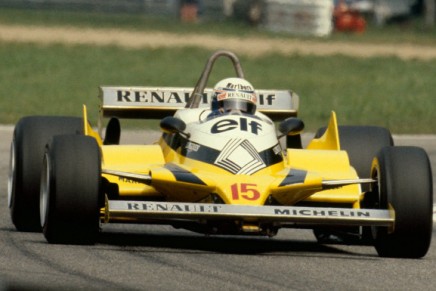
The Renault F1 team’s next few seasons were marked by ups and downs. They continued to score podium finishes and occasional race victories but could not mount a serious challenge for the world championship.
This changed in 1981 when the team unveiled its latest creation, the RE30. The RE30 was designed by Gerard Ducarouge and featured several technical innovations that would make it one of the most competitive cars of the season.
The car featured a powerful turbocharged engine, which gave it a significant performance advantage over its rivals. It also had a highly aerodynamic body, with a distinctive “shark nose” front end that would become a hallmark of the Alpine Renault F1 team’s cars.
The RE30 was a dominant car throughout the season, with drivers Alain Prost and Rene Arnoux scoring several race victories and podium finishes. Prost, in particular, had an outstanding season, winning four races and finishing second in the world championship.
The RE30B Car
The following year, the team unveiled an evolution of the RE30, the RE30B. This car was even more competitive than its predecessor, thanks to several technical improvements and refinements.
Once again, Prost and Arnoux was a formidable pairing, scoring several race victories and podium finishes throughout the season. Prost went on to win his first world championship, with Arnoux finishing third in the standings.
The team dropped Jenson Button in 2003 to make way for Fernando Alonso. In 2004 they took on Giancarlo Fisichella.
Although Ferrari and McLaren were strong, Renault beat both to win the 2005 and 2006 championships.
At 24, Fernando became the youngest Formula One World Champion. The invigorated team won 15 podiums and seven wins, earning them the Constructors’ Championship.
The Post Championship Years
Alonso left the team to join McLaren for the 2007 season.
The team never really recovered, and even though Alonso rejoined Renault, he only managed two victories in 2008 and one podium in 2009.
After Nelson Piquet’s 2008 crash in Singapore 2008, the team had to also contend with race-fixing allegations. The findings were that Piquet crashed to bring out a safe car and guarantee his teammate winning.
The punishment was that the team was put on probation. Almost all of the assets were sold to Genii Capital in Luxembourg.

Lotus joined the team in 2011 to help it recover. Renaults bought most of the team’s assets and renamed Lotus Renault GP. They remained involved between 2011 and 2015. It wasn’t a happy partnership, and the lawyers were often called in to resolve these.
Renault Sport Formula One
After several years of supplying engines to other teams, in 2016, Renault announced that it would return to Formula One as a full works team using the Lotus Renault GP, renamed Renault Sport Formula One.
The Renault F1 team would be based in Enstone, UK, and would be led by Cyril Abiteboul.
The team’s return to Formula One was seen as a positive development for the sport, as Renault has a long and storied history in motorsport and was expected to bring significant expertise and resources to the table.
Despite this, the team has struggled to gain traction, and, at best, they remain in the middle order.
The Name Change – The Alpine Renault F1 Team
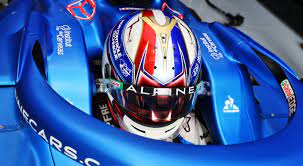
In September 2020, the Renault F1 team announced it would change its name to Alpine for the 2021 season. The process was part of a larger restructuring of the Renault Group’s brands and products, which aimed to increase the visibility and prestige of the Alpine brand.
The decision to change the team’s name was seen as a logical step, given the Renault Group’s increasing focus on the Alpine brand. By aligning the F1 team with the Alpine brand, the Renault Group could leverage its success and visibility to promote the Alpine brand and increase its market share.
Changing the team’s name was also seen as a way to inject new energy and excitement into the team. Despite its long and storied history in Formula One, the Renault F1 team had struggled to maintain its competitive edge in recent years, and a fresh start under a new name could be just what the team needed to turn things around.
What Does This Mean for the Team?
The change from Renault to Alpine represents a significant shift for the F1 team. Here are some of the key implications of the name change:
Increased Visibility for the Alpine Brand
As mentioned earlier, the Renault Group has been seeking to increase the visibility and prestige of the Alpine brand. By aligning the F1 team with the Alpine brand, the Renault Group hopes to leverage the team’s success and visibility to promote the Alpine brand and increase its market share.
A Fresh Start – The Alpine Renault F1 Team
The Renault F1 team has recently struggled to maintain its competitive edge despite investing heavily in the sport. A fresh start under a new name may help the team regain its competitive edge.
New Identity: The name change to Alpine represents a new identity for the team, with a different focus and emphasis. While the Renault F1 team had a long and storied history in Formula One, it struggled to establish a clear identity and vision in recent years. The Alpine F1 team can now build its own identity and vision, focusing on promoting the Alpine brand and its high-performance sports cars.
Potential for More Investment: The Renault Group has indicated that it plans to increase its investment in the Alpine brand to expand its product lineup and market share. This could also mean more investment in the F1 team, aiming to improve its competitiveness and success on the track.
A New Team Principal
With the name change to Alpine, the team also announced that Cyril Abiteboul would be leaving. Laurent Rossi, who previously headed up the Alpine brand, will be the team principal. This change in leadership could bring a fresh perspective and new ideas to the team.
Overall, the change from Renault to Alpine represents a significant shift for the F1 team, with implications for the team’s identity, focus, and competitiveness.
The team will be under its new name and leadership, there is optimism that the change could help the team regain its competitive edge and achieve greater success.
Alpine F1 Drivers Through The Years
As listed below, many well-known and iconic F1 drivers have passed through the team.
| Driver | Years With The Team | Points | Drivers World Championships |
|---|---|---|---|
| Jean-Pierre Jabouille | 1977-80 | 21 | 0 |
| Rene Arnoux | 1979-82 | 85 | 0 |
| Alain Prost | 1981-83 | 134 | 0 |
| Eddie Cheever | 1983 | 22 | 0 |
| Derek Warwick | 1984-85 | 28 | 0 |
| Patrick Tambay | 1984-85 | 22 | 0 |
| Philippe Streiff | 1984 | – | 0 |
| Francois Hesnault | 1985 | – | 0 |
| Jenson Button | 2002 | 14 | 0 |
| Jarno Trulli | 2002-04 | 88 | 0 |
| Fernando Alonso | 2003-06, 2008-09, 2022 | 468 | 2 |
| Jacques Villeneuve | 2004 | – | 0 |
| Giancarlo Fisichella | 2005-07 | 151 | 0 |
| Heikki Kovalainen | 2007 | 30 | 0 |
| Nelsinho Piquet | 2008-09 | 19 | 0 |
| Romain Grosjean | 2009 | 0 | 0 |
| Robert Kubica | 2010 | 136 | 0 |
| Vitaly Petrov | 2010-11 | 64 | 0 |
| Nick Heidfeld | 2011 | 34 | 0 |
| Bruno Senna | 2011 | 2 | 0 |
| Jolyon Palmer | 2016-17 | 9 | 0 |
| Kevin Magnussen | 2016 | 7 | 0 |
| Nico Hulkenberg | 2017-19 | 149 | 0 |
| Carlos Sainz | 2017-18 | 59 | 0 |
| Daniel Ricciardo | 2019 – 2021 | 0 | |
| Esteban Ocon | 2020 – current | 0 | |
| Pierre Gasly | 2023 current | 0 |

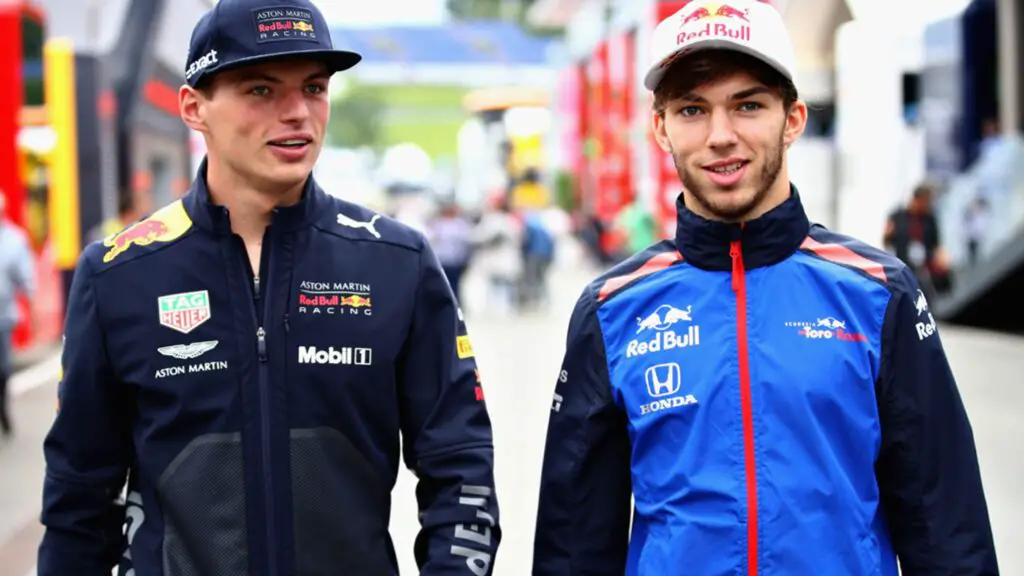
Renaults Racing Wins
The table below lists all the Renault F1 wins
| No | Race | Driver |
| Year 1906 | ||
| 1 | French Grand Prix | Ferenc Szisz |
| Year 1979 | ||
| 2 | French Grand Prix | Jean-Pierre Jabouille |
| Year 1980 | ||
| 3 | Brazilian Grand Prix | René Arnoux |
| 4 | South African Grand Prix | René Arnoux |
| 5 | Austrian Grand Prix | Jean-Pierre Jabouille |
| Year 1980 | ||
| 6 | French Grand Prix | Alain Prost |
| 7 | Dutch Grand Prix | Alain Prost |
| 8 | Italian Grand Prix | Alain Prost |
| Year 1980 | ||
| 9 | South African Grand Prix | Alain Prost |
| 10 | Brazilian Grand Prix | Alain Prost |
| 11 | French Grand Prix | René Arnoux |
| 12 | Italian Grand Prix | René Arnoux |
| Year 1983 | ||
| 13 | French Grand Prix | Alain Prost |
| 14 | Belgian Grand Prix | Alain Prost |
| 15 | British Grand Prix | Alain Prost |
| 16 | Austrian Grand Prix | Alain Prost |
| Year 2003 | ||
| 17 | Hungarian Grand Prix | Fernando Alonso |
| Year 2004 | ||
| 18 | Monaco Grand Prix | Jarno Trulli |
| Year 2005 | ||
| 19 | Australian Grand Prix | Giancarlo Fisichella |
| 20 | Malaysian Grand Prix | Fernando Alonso |
| 21 | Bahrain Grand Prix | Fernando Alonso |
| 22 | San Marino Grand Prix | Fernando Alonso |
| 23 | European Grand Prix | Fernando Alonso |
| 24 | French Grand Prix | Fernando Alonso |
| 25 | German Grand Prix | Fernando Alonso |
| 26 | Chinese Grand Prix | Fernando Alonso |
| Year 2005 | ||
| 27 | Bahrain Grand Prix | Fernando Alonso |
| 28 | Malaysian Grand Prix | Giancarlo Fisichella |
| 29 | Australian Grand Prix | Fernando Alonso |
| 30 | Spanish Grand Prix | Fernando Alonso |
| 31 | Monaco Grand Prix | Fernando Alonso |
| 32 | British Grand Prix | Fernando Alonso |
| 33 | Canadian Grand Prix | Fernando Alonso |
| 34 | Japanese Grand Prix | Fernando Alonso |
| Year 2005 | ||
| 35 | Singapore Grand Prix | Fernando Alonso |
| 36 | Japanese Grand Prix | Fernando Alonso |
Renault Racing Statistics
Benneton’s Racing records are listed below.
| Metric | Value |
|---|---|
| No Of Grands Prix Raced | 400 |
| Number of DNS (Did Not Start) | 13 |
| Number of seasons raced | 24 |
| Number of engine builders | 1 |
| Number of drivers | 31 |
| Number of car models | 27 |
| Number of race wins | 35 |
| Number of pole positions achieved | 51 |
| Number of fastest laps | 33 |
| Number of podiums | 103 |
| Number of championship points | 1,777 |
| Points per GP raced | 4,44 |
| Points per season | 74.04 |
| Number of laps raced | 38,338 |
| Number of Km raced | 187,515 |
Conclusion
With the merging of their interests and the investment made in the Alpine/ Renault team, everyone is holding thumbs that it ascends again.

